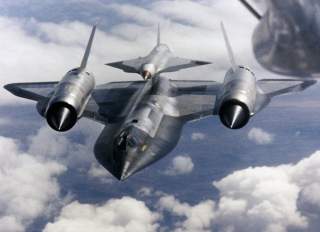The Mach 3 D-21 Drone Was a Secret America Cold War Spy Machine
It was used to keep tabs on Red China.
Key point: It was only recently that Cold War documents were declassified, providing more details on the D-21's many spy missions.
Between 1969 and 1971, the U.S. National Reconnaissance Office deployed super-fast spy drones over China in an abortive attempt to spy on Beijing's nuclear program.
The NRO on March 21, 2019 declassified scores of five-decade-old records documenting the development, deployment and termination of the "Tagboard" drone system.
Tagboard's air vehicle was the Lockheed-made D-21 drone. It was an impressive example of brute-force, mid-century engineering.
Made of titanium and weighing 12 tons, the 19-feet-wingspan D-21 in its early forms launched from atop a special variant of the A-12, the CIA's version of the Mach-3 SR-71. The A-12, in essence, was the booster for the drone, climbing to 80,000 feet of altitude and accelerating to Mach 3.3 before separating from the pilotless vehicle.
The D-21's ramjet engine took over, allowing it to cruise at three times the speed of sound for as far as 3,000 miles. A 300-pound Hycon HR 335 camera peering through the drone's lower fuselage could capture 5,600 exposures covering an area 16 miles wide and 3,900 miles long.
The drone followed a pre-programmed flight path and maintained only intermittent radio contact with the launch plane that allowed an operator to monitor the drone's performance. As it reached its final waypoint, the D-21 jettisoned a capsule containing its exposed film then self-destructed.
The film descended on a parachute. The plan was for a special JC-130 transport plane to snatch the parachute in mid-air. Failing that, a Navy ship could fish the capsule from the ocean.
The military and intelligence communities in the late 1960s hoped the D-21 would help the United States to spy on strategic targets more reliably than a satellite could do at that time, and without risking a human pilot.
"The Tagboard drone provides a unique technical capability to satisfy national requirements to conduct imagery reconnaissance operations against targets hostile or potentially hostile to the United States," the Joint Chiefs of Staff explained in a September 1969 memo.
"In view of the political sensitivity to overflight of certain denied areas, such as China, by manned collection systems and the technical and other limitations of the current satellite program, the Tagboard operational capability has been developed to collect against objectives of national interest located in areas where manned operations could provoke incidents potentially embarrassing to the United States."
But it was a complex and costly system. Two A-12 launch planes and 20 drones cost $440 million in 2019 dollars. A fatal crash during a July 1966 abruptly ended the effort to combine the A-12 and D-21. The NRO added a rocket booster to the D-21 and migrated the system to a small fleet of lightly-modified B-52H bombers.
By 1969 the D-21 was ready for action. China had tested its first atomic warhead in 1964. Washington was very interested in Beijing's nuclear facilities in southern China -- facilities that satellites at the time failed adequately to surveil. "Ninety-three percent of the high-priority South China targets had no coverage during the previous two months," the Joint Chiefs of Staff explained in its September 1969 memo.
The Joint Chiefs assumed China's radars would detect an incoming D-21. But Chinese SA-2 air-defense missile systems "are not considered to pose a threat to the Tagboard drone."
The NRO oversaw four D-21 missions over China. The agency characterized all four as "unsuccessful." The third mission launched on March 4, 1971. Its results apparently are representative of the success of the overall program. The drone completed its recon run but failed to safely eject its film capsule.
"The parachute system was partially disabled by loss of the air pickup chute which prevented an air snatch by the JC-130 aircraft," the NRO reported to the Defense Department. "There is a strong probability that a malfunctioning valve prevented adequate cooling of the parachute compartment during flight of the drone. The resultant overheat condition, sustained for over an hour, could have degraded the tensile strength of parachute components."
"Although the main parachute canopy lowered the payload to the water surface, a subsequent pickup attempt by a Navy vessel was unsuccessful due to procedural errors, and the payload sank."
The NRO attempted one more D-21 mission over China on March 20, but it too ended in failure. By mid-1971 the NRO had decided to entirely abandon aerial reconnaissance in favor of a purely satellite-based intelligence-collection effort. "I have become increasingly convinced that we should be expending our efforts on upgrading our satellite activities, rather than trying to continue with air-breathing vehicles," NRO director John McLucas wrote in an April 1971 memo.
McLucas noted that new spy satellites were spending more time in orbit. In 1971, Corona, Gambit and Hexagon spy sats would rack up a combined 181 days in orbit, McLucas reported. He projected days-on-orbit would grow to 279 by 1974.
Unsafe, unreliable drones were no longer necessary for strategic overhead reconnaissance, the NRO concluded. But McLucas for one anticipated that drones might some day make a big comeback in a different mission. "I believe that there is a weapons-carrying role for drones which ought to be exploited."
Surviving D-21s reside at several U.S. museums. China recovered the wreck of one self-destructed D-21 and put it on display in Beijing.
David Axe serves as Defense Editor of the National Interest. He is the author of the graphic novels War Fix, War Is Boring and Machete Squad. This first appeared in April 2019.
Image: Wikimedia

